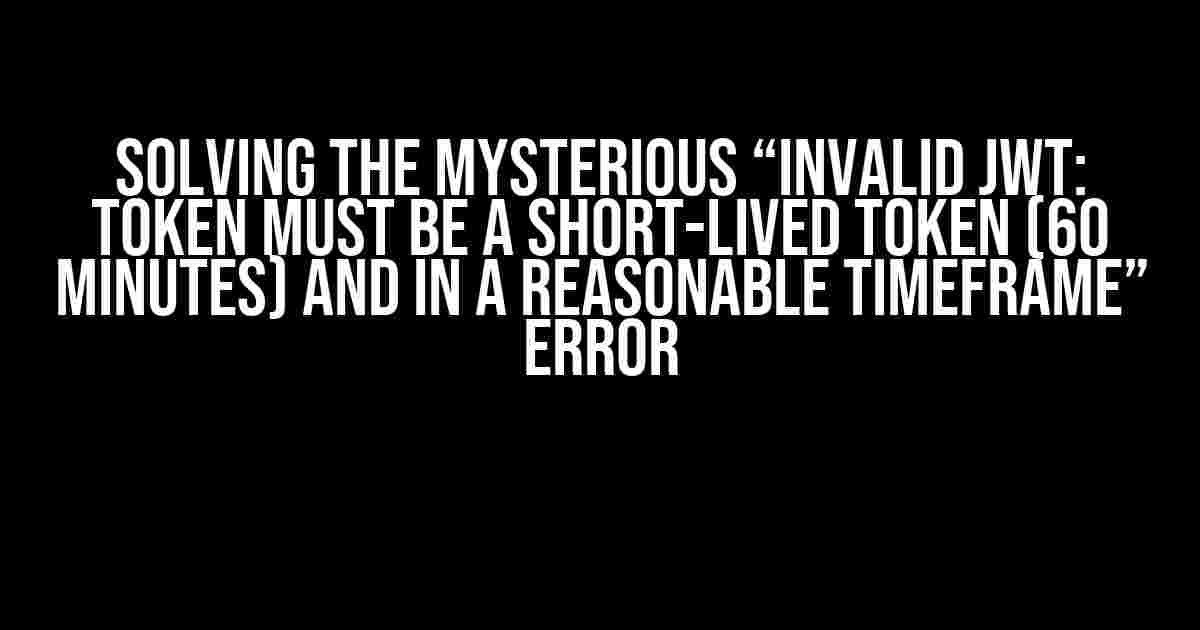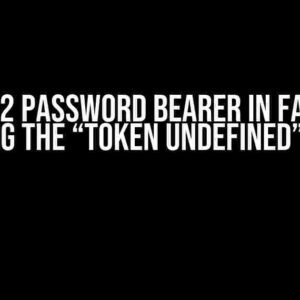Ah, the infamous “Invalid JWT” error. You’ve probably spent hours pouring over lines of code, wondering where you went wrong. But fear not, dear developer, for today we shall conquer this beast together. In this article, we’ll delve into the mysterious world of JWT (JSON Web Tokens) and uncover the secrets behind this pesky error message.
What is a JWT, anyway?
Before we dive into the solution, let’s take a step back and understand what a JWT is. A JSON Web Token is a compact, URL-safe means of representing claims to be transferred between two parties. It’s like a digital ID card that verifies your identity and grants access to protected resources. JWTs consist of three parts: the header, payload, and signature.
{
"alg": "HS256",
"typ": "JWT"
}.
{
"exp": 1643723900,
"iat": 1643720300,
"sub": "1234567890"
}.
[signature]
In this example, the header specifies the algorithm used (HS256), the payload contains claims such as expiration time (exp) and issued at time (iat), and the signature is a digital fingerprint that verifies the token’s authenticity.
The “Invalid JWT” Error: What Does it Mean?
So, why does this error occur? The “Invalid JWT: Token must be a short-lived token (60 minutes) and in a reasonable timeframe” error message indicates that the JWT you’re using is either invalid or has expired. There are two main reasons for this error:
- Token lifetime exceeds 60 minutes**: JWTs are meant to be short-lived, and most services enforce a 60-minute maximum lifetime. If your token exceeds this limit, it will be rejected.
- Token is not in a reasonable timeframe**: The token’s issued at time (iat) or expiration time (exp) is outside a reasonable range. This could be due to clock skew or incorrect timezone settings.
Troubleshooting Steps: Solve the Error
Now that we understand the error, let’s walk through the steps to resolve it:
- Check your token’s lifetime**: Review your code and ensure that your JWT’s lifetime does not exceed 60 minutes. If it does, adjust the expiration time accordingly.
- Verify your system clock**: Ensure your system clock is accurate and synchronized with the server’s clock. A small discrepancy can cause the token to be rejected.
- Validate your timezone settings**: Double-check your timezone settings to ensure they match the server’s timezone. Incorrect timezone settings can lead to incorrect token timestamps.
- Regenerate the token**: If you’ve made changes to your token generation process, try regenerating the token to ensure it’s fresh and valid.
- Check for clock skew**: If you’re using a distributed system, verify that all nodes have synchronized clocks to prevent clock skew.
Example Code: Generating a Valid JWT in Node.js
const jwt = require('jsonwebtoken');
const payload = {
exp: Math.floor(Date.now() / 1000) + 60 * 60, // expires in 1 hour
iat: Math.floor(Date.now() / 1000), // issued at current time
sub: '1234567890' // subject (user ID)
};
const token = jwt.sign(payload, 'your-secret-key', { algorithm: 'HS256' });
In this example, we generate a JWT with an expiration time set to 1 hour from the current time, and an issued at time set to the current time.
Common Scenarios and Solutions
Let’s explore some common scenarios that can lead to the “Invalid JWT” error and their solutions:
| Scenario | Error Cause | Solution |
|---|---|---|
| Using an old token | Token has expired | Regenerate the token with an updated expiration time |
| Incorrect system clock | Clock skew or incorrect timezone | Synchronize system clock with server clock and verify timezone settings |
| Token generated with incorrect algorithm | Algorithm mismatch | Use the correct algorithm (e.g., HS256) when generating the token |
| Distributed system with unsynchronized clocks | Clock skew across nodes | Synchronize clocks across all nodes to prevent clock skew |
Conclusion
The “Invalid JWT: Token must be a short-lived token (60 minutes) and in a reasonable timeframe” error can be frustrating, but by following the troubleshooting steps and understanding the underlying causes, you’ll be well-equipped to solve this issue. Remember to keep your tokens short-lived, ensure your system clock is accurate, and validate your timezone settings. With these best practices in mind, you’ll be generating valid JWTs in no time!
Now, go forth and conquer the world of JWTs!Here are 5 Questions and Answers about “Invalid JWT: Token must be a short-lived token (60 minutes) and in a reasonable timeframe”:
Frequently Asked Question
Get the lowdown on that pesky “Invalid JWT” error! 🤔
What does “Invalid JWT” mean?
Don’t panic! 😊 “Invalid JWT” simply means that your JSON Web Token (JWT) is not meeting the security requirements. In this case, it’s complaining about the token’s lifetime and timeframe.
What’s the deal with the 60-minute lifetime?
The 60-minute lifetime is a security best practice to prevent token abuse. It ensures that even if a token is compromised, it will automatically expire within an hour, minimizing the damage. So, make sure your token is generated with a relatively short lifetime! ⏰
What’s a “reasonable timeframe”?
A reasonable timeframe means that the token’s issued-at (iat) and expiration (exp) timestamps should be within a reasonable range. This prevents tokens from being generated with arbitrary dates, which could lead to security issues. Think of it as keeping your token’s birth and death certificates in check! 📆
How can I fix this error?
Easy peasy! 😊 Regenerate your JWT with a shorter lifetime (less than 60 minutes) and ensure the issued-at and expiration timestamps are within a reasonable range. You can use libraries like jsonwebtoken or auth0 to generate secure tokens.
Will I still encounter issues if I fix this?
Not necessarily! 🙅♂️ Fixing the JWT lifetime and timeframe should resolve the “Invalid JWT” error. However, there might be other security or configuration issues lurking in the shadows. Keep an eye out for other error messages or unusual behavior, and you’ll be all set! 👍



